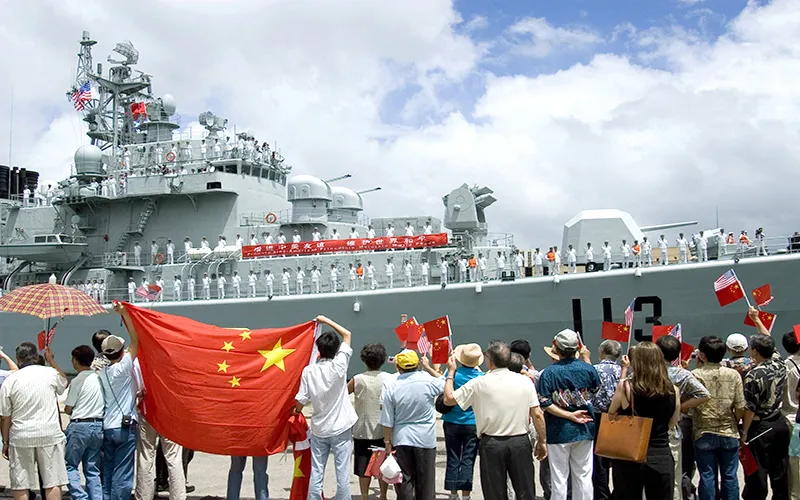-
CENTRES
Progammes & Centres
Location
As China continues to expand its presence in international waters, it is developing capabilities to counter foreign submarines which, otherwise, may pose challenge to its ambitions. This is where the recently launched Gaoxin-6 becomes important for Beijing.

With the commissioning of Gaoxin-6, also called as Y-8GX6, into the PLA Navy's (PLAN) North Fleet, China's anti-submarine warfare capabilities appears to have advanced significantly. Even though China has been paying greater attention to overall naval modernisation, there remain several areas that it needs to catch up on. Anti-submarine capability is one front where China for long has been lagging behind. With the induction of Gaoxin-6, China seems to have filled that capability gap. The Gaoxin-6 aircraft had been in the testing stage for several years - the first flight test took place in 2012. Gaoxin-6's commissioning within three years of testing underlines the urgency with which China has pursued anti-submarine capability.
Military and security experts, who have been tracking the developments for a while, suggest that using Y-8 and Y-9 transport aircraft as base platforms, China has gone on to make 10 different planes under the series called Gaoxin. China developed these by altering fuselages and fitting new electronic systems for a range of civil and military utilities such as electronic reconnaissance, marine patrol, anti-submarine, air control, early warning and air survey. Many of these are reported to have entered the service.
Gaoxin-6 aircraft, in particular, uses advanced 6-leaf sweepback turboprop engine allowing it to achieve superior range, speed, coverage and endurance. Before commissioning Gaoxin-6, China had to rely on anti-submarine helicopters. Capabilities of Gaoxin-6, as Chen Hu, a military expert, argues, make it equivalent to 100 anti-submarine helicopters. Gaoxin-6 is, thus, certainly a leap in China's anti-submarine capability.
Gaoxin-6 is considered to be China's own version of the American P-3C maritime patrol and anti-submarine aircraft, although the P-3 made its first appearance in the 1960s. The US is in fact planning to replace them with P-8A Poseidon. Both Gaoxin-6 and P-3C have similarities in terms of their overall shape and equipments used. While there remain uncertainties on whether Gaoxin-6 and P-3C can demonstrate similar capabilities, some Chinese experts claim that Gaoxin-6 even surpasses P-3C in certain regards.
It is claimed that Gaoxin-6 aircraft's speed and take-off weight are similar to that of P-3C. Gaoxin-6 is also equipped with a gill-shaped fairing on its nose, which combined with a 360-degree large sea search radar increases its surveillance coverage. There is also a "magnetic anomaly detector" installed in its tail which is useful in detecting submarines. With an antenna longer than that of P-3C, Gaoxin-6 probably has better submarine detection capability.
Gaoxin-6 is equipped with both offensive and defensive weapons. As an anti-submarine aircraft, it carries weapons like torpedoes, depth charges, mines and air-to-submarine missiles. It also has self-defence warning system and air-to-air missile. Its ability to respond to air threats makes it similar to P-3C.
Some experts are in fact arguing that "there is no great technical generation gap of anti-submarine capabilities between Gaoxin-6, Japan's P-1 and US P-8A" Poseidon aircraft, although they also note that Gaoxin-6 lacks in terms of software, when compared to advanced anti-submarine aircrafts like the P-8A. Thus, while Gaoxin-6 fills in the void in PLA's anti-submarine warfare capabilities, China is likely to continue developing more advanced anti-submarine aircrafts.
The US Navy has stationed dozens of attack submarines as well as strategic nuclear missile submarines in the Indo-Pacific waters. Japan, with which China continues to remain embroiled in territorial dispute, also possesses 20 advanced submarines. With its interest growing in regions beyond its immediate waters, China is also eyeing the rise of submarine warfare capabilities of some of the major Indian Ocean naval powers, such as India, Australia, Indonesia and Vietnam. As China continues to expand its presence in international waters, it is developing capabilities to counter foreign submarines which, otherwise, may pose challenge to its ambitions. This is where Gaoxin-6 becomes important for Beijing. However, considering that countries like India and Japan are now acquiring and developing advanced anti-submarine aircrafts, China will find that its advances are being matched by others in the region, at least in qualitative terms if not in quantity.
(Dr. Rajeswari Pillai Rajagopalan is a Senior Fellow and Arka Biswas a Junior Fellow at Observer Research Foundation, Delhi)
The views expressed above belong to the author(s). ORF research and analyses now available on Telegram! Click here to access our curated content — blogs, longforms and interviews.

Dr Rajeswari (Raji) Pillai Rajagopalan was the Director of the Centre for Security, Strategy and Technology (CSST) at the Observer Research Foundation, New Delhi. Dr ...
Read More +